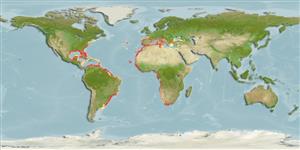Classificação / Names
Common names from other countries
Referência principal
Tamanho / Peso / Idade
Max length : 30.0 cm TL macho/indeterminado; (Ref. 188); common length : 25.0 cm SL macho/indeterminado; (Ref. 188); Peso máx. publicado: 229.00 g (Ref. 5217); Idade máx. registada: 7 anos (Ref. 839)
Length at first maturity
Lm 14.4, range 14 - 21.5 cm
Ambiente
; marinhas; estuarina associadas(os) a recifes; oceanódromo (Ref. 51243); intervalo de profundidade 0 - 350 m (Ref. 5286)
Clima / Intervalo
Subtropical; 24°C - ? (Ref. 54867), preferred 24°C (Ref. 107945); 47°N - 40°S, 98°W - 43°E (Ref. 54867)
Distribuição
Atlantic Ocean: West African coast from Gibraltar southward to Saldanha Bay in South Africa (Ref. 188, 81269, 81631); also in Mediterranean Sea (Ref. 188, 81631) and Black Sea (Ref. 188). In western Atlantic Ocean from Cape Cod in USA to Argentina (Ref. 188), including Bahamas, Antilles, Gulf of Mexico and the Caribbean coast (Ref. 26938).
Países | Áreas FAO | Ecossistemas | Ocorrências | Introduções
Descrição breve
Espinhos dorsais (total): 0; Raios dorsais moles (total): 13-21; Espinhos anais 0; Raios anais moles: 12 - 23. Diagnosis: Body elongate, usually subcylindrical, but sometimes a little compressed; belly rather rounded, but scutes apparent (Ref. 188, 81269). Lower gillrakers fine and numerous, more than 80; anterior gillrakers on lower limbs of second and third gill arches lying more or less flat (Ref. 188). The pelvic finray count of 1 unbranched and 8 branched rays distinguishes Sardinella aurita from all other species of Sardinella, Harengula, Opisthonema, Herklotsichthys and Amblygaster that occur with it (Ref. 188). It resembles Clupea but it has two fleshy outgrowths along outer margin of gill opening and numerous fine fronto-parietal striae on top of head (Ref. 188). Flanks silvery, with a faint golden midlateral line, preceded by a faint golden spot behind gill opening; a distinct black spot at hind border of gill cover (Ref. 188, 3259).
Categoria na Lista Vermelha da IUCN (Ref. 115185)
Ameaça para o homem
Harmless
Utilização humana
Pescarias: altamente comercial; isco: usually
Ferramentas
Relatórios especiais
Descarregue XML
Fontes da internet
Estimates of some properties based on models
Phylogenetic diversity index
PD50 = 0.5000 many relatives (e.g. carps) 0.5 - 2.0 few relatives (e.g. lungfishes)
Nível Trófico
3.4 ±0.5 se; Based on diet studies.
Resiliência
Elevada, tempo mínimo de duplicação da população menor que 15 meses (K=0.25-1.2; tm=1; tmax=7)
Vulnerabilidade
Low to moderate vulnerability (25 of 100)
Categoria de preço
